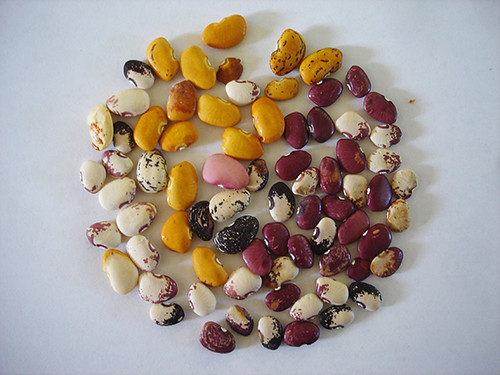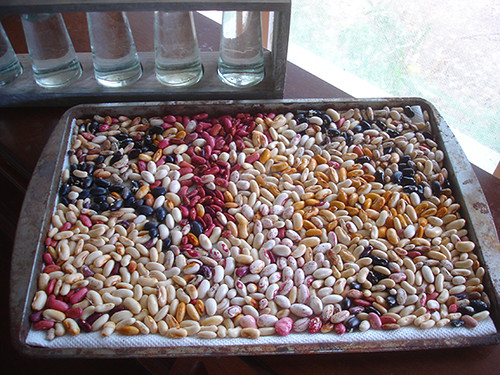|
|
Post by silverleaf on Jul 13, 2014 21:36:09 GMT -5
I'm intrigued by this landrace idea. I always want to try growing lots of different varieties and don't really have the space, and it seems like a great way to select for my conditions without too much work and no time-and-space-consuming isolation and record-keeping.
I started by collecting a small selection of varieties to mix together (a few were donated, some are commercial seed, and some from my own seed saving), aiming to create I guess 4 races: runners for drying, runners for pods, climbing French beans for drying, and climbing French beans for pods.
Is it reasonable to mix up runners and French beans, so I'd have a dry race and a pod race, both comprised of two different species?
I tried to to order some interesting-looking accessions from GRIN to add in more variety, but unfortunately they can't send any Phaseolus to me in the UK because they can't provide certification that the seeds are free from some disease (I forget which it was). Sad times!
So does anyone have advice or tips for me, other than just get a bunch of seeds together and plant them and save seeds from whatever grows well and tastes okay? Is there anything else I need to think of? Any other types of beans I should consider to add to the mix(es)? I've grown French beans before but this is the first year I've grown runners.
|
|
|
|
Post by Joseph Lofthouse on Jul 27, 2014 17:37:17 GMT -5
I feel perfectly content with landraces containing multiple species, as long as the species are compatible with each other. For example garden peas and common beans don't mix well because one grows best in cold weather and the other only in hot weather. Runner beans and common snap beans are both warm weather crops and grow fine together. They cook fine together. No problem. And even if a problem is noticed later on, it is trivial to separate the seeds at any time.
Runners and common beans are close enough genetically that some inter-species hybrids might show up eventually. That'd be way cool! Also if the dry beans and the edible pod beans are grown close together there will eventually be some crossing. Might be somewhere in the ballpark of 1 in 20 to 1 in 200. That's not a problem for the dry beans, but I like my snap beans to snap and not be fibrous.
|
|
|
|
Post by silverleaf on Jul 29, 2014 19:44:50 GMT -5
Thanks!
Two races it is then. I'm planning to separate the pod race and the seed/shelling race as much as I can and distract the bees by having flowers they really like in between the two groups. I suppose a little crossing's inevitable as I'm working in a limited space (my garden's about about 1/4 acre) but I'll just have to live with it.
I've seen runner-French hybrid seeds for sale here, which apparently solves the problem of poor pod set you sometimes get with runners because they self-pollinate like their French parent. Interesting!
I was also given a handful of cowpeas recently which I'll add to the seed/shelling landrace too. Never grown them before either, but the guy who gave them to me says they produce well for him. I'm further north so it's a little colder here, but shouldn't be too much of an issue.
|
|
|
|
Post by 12540dumont on Jul 31, 2014 10:49:02 GMT -5
I don't know if you'll be able to keep the runners from making once race. On the farm the hummingbirds and bumblebees go from runner to phaseolus to runner to phaseolus. (My runners come up every year from root stock). But I know that some of the beans that spill to the ground and restart the following year are crossed. I don't worry about it. But those runners are out breeders. If possible, try to keep the pods all in a row and the snaps in a different row, separated at each end of your garden. Let us know how you do. I love bean projects.
|
|
|
|
Post by flowerweaver on Jul 31, 2014 11:47:45 GMT -5
Wishing you success! I started several bean landrace projects this year. I have a small farm and was able to grow 10 kinds of soybeans, 18 kinds of pole beans, 25 kinds of bush beans, and eight kinds of lima beans. I only tried one kind of runner bean and it bloomed profusely but never put on any beans before dying. I haven't seen any evidence of it crossing with my pole beans, which greatly suffered when their trellis was downed by a tornado. The lima beans were on sturdy wooden trellises and produced reasonably well, and the bush beans that were flattened by the hail continued to produce, although about a third of the pods touching the ground rotted. Lima bean landrace  Bush bean landrace  |
|
|
|
Post by 12540dumont on Jul 31, 2014 17:38:11 GMT -5
Wow, your beans look like the ones Joseph sent me, sort of.
|
|
|
|
Post by silverleaf on Aug 5, 2014 16:43:04 GMT -5
Those beans look fantastic! I'm not sure if limas grow well here or not.
My runners are looking good despite being in very late, just starting to flower now. It's very weird to me seeing scarlet bean flowers when I'm used to the white-to-purple spectrum of common beans, and I'm really excited to see how they do.
I've isolated the runners as best I can. Pod types for seed are in one area, pod and dry bean types for eating at the other side of the back garden with tempting plants for bees in between. I don't care if the eating ones cross because I'm only going to eat them! The dry types for seed are in the front garden so a house I between them and the others. I have enough pure seed for next year anyway, so if it all goes horribly wrong I can start over.
It sounds like quite a few of you are having problems with runner pod set in hot weather - perhaps you should try one of the common/runner hybrids that can self-pollinate?
|
|
|
|
Post by steev on Aug 5, 2014 21:04:40 GMT -5
I have P. coccinius survival problems, let alone pod-set. P vulgaris, in general, also doesn't like the environment on my farm. P. lunatus is disgruntled, but stoic. Oh, well, Vigna seems happy enough, though tiny little buggers, mostly.
I suppose I'll get used to eating fewer green beans and more long beans, less chili and more dal; as a human, it's my job: to adapt and survive.
|
|
|
|
Post by flowerweaver on Aug 6, 2014 15:11:43 GMT -5
I'm starting my cowpea landrace this week with 30+ varieties. The few we've grown in the past did exceedingly well so it will be interesting to see which ones come out as winners. Hopefully they will feed us through the winter since most of the P. vulgaris was trashed in the tornado.
The exception are some long season beans from Mexico that were apparently pole type that I accidentally planted in the bush bean field. They took off after the storm and have consumed the patch from sea to shining sea. Tons of flowers on them, so there should be a good harvest there.
|
|